HAT301A Revenue Management: Strategies, Analysis, and Application
VerifiedAdded on 2023/06/11
|11
|2699
|217
Report
AI Summary
This report provides a detailed analysis of revenue management strategies within the hospitality industry, focusing on key performance indicators such as occupancy rate, Average Daily Rate (ADR), and Revenue per Available Room (RevPAR). It examines STR reports to derive findings related to hotel performance compared to its competitive set, identifying areas of strength and weakness. Furthermore, the report explores alternative methods for competitor analysis, like H-CAT and SEO, and proposes yield management strategies, including market segmentation, open pricing, demand calendars, data maintenance, and enhanced direct booking. The communication of these strategies to key stakeholders like investors, suppliers, and employees is also discussed, along with the application of yield management in marketing, sales, and technology. Desklib offers this student-contributed assignment to aid other students in their studies, alongside a wealth of resources including past papers and solved assignments.
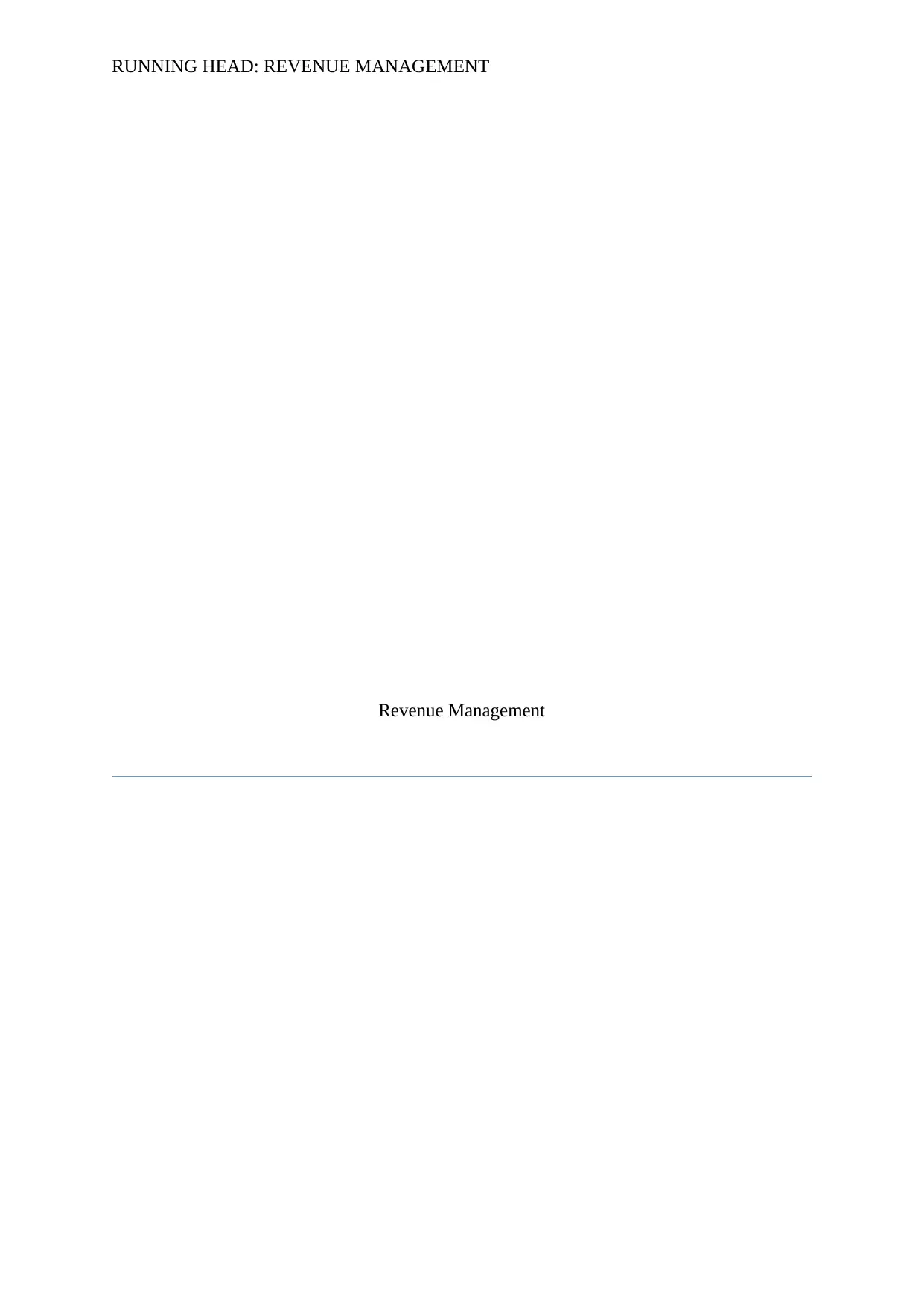
RUNNING HEAD: REVENUE MANAGEMENT
Revenue Management
Revenue Management
Paraphrase This Document
Need a fresh take? Get an instant paraphrase of this document with our AI Paraphraser
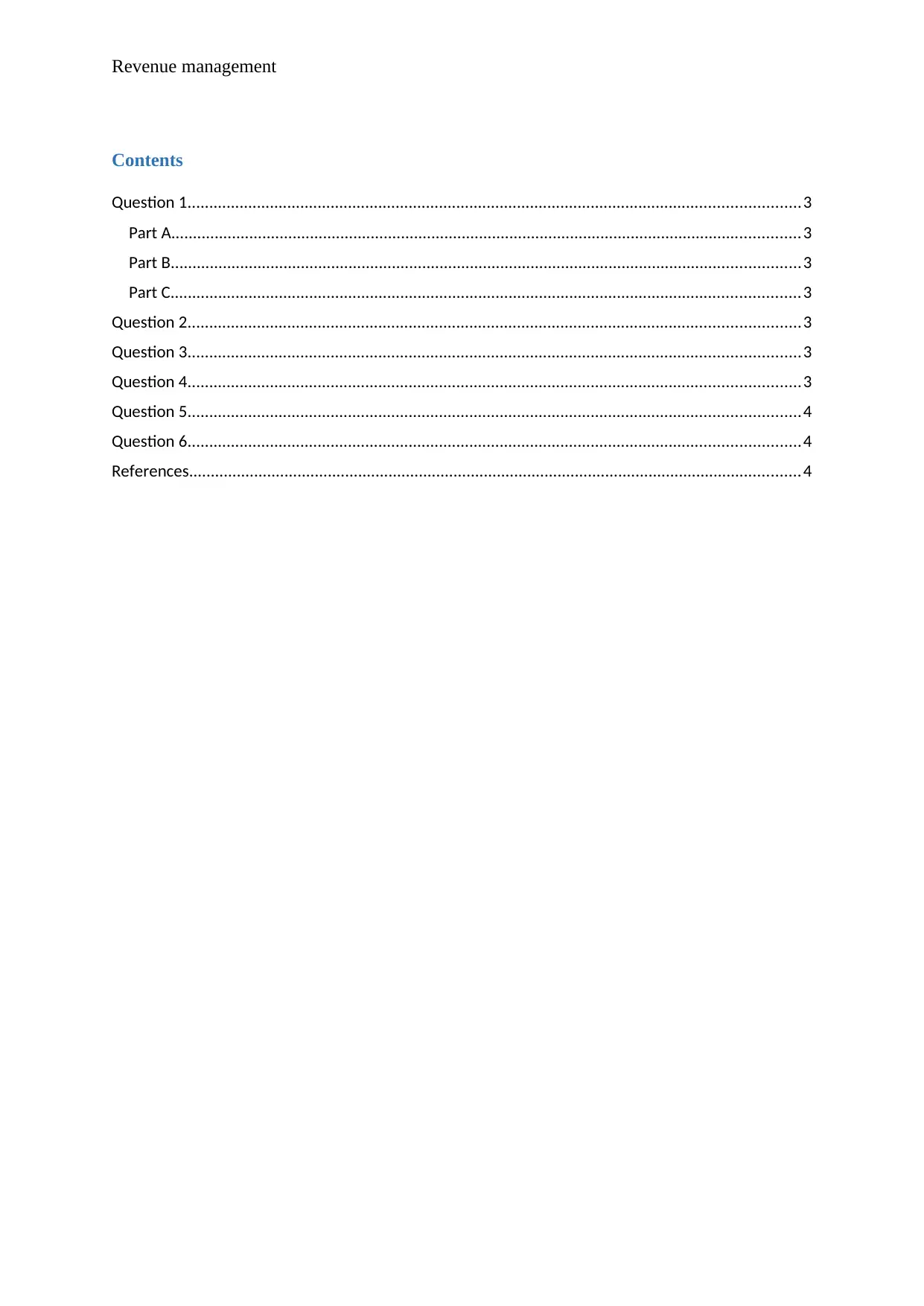
Revenue management
Contents
Question 1.............................................................................................................................................3
Part A.................................................................................................................................................3
Part B.................................................................................................................................................3
Part C.................................................................................................................................................3
Question 2.............................................................................................................................................3
Question 3.............................................................................................................................................3
Question 4.............................................................................................................................................3
Question 5.............................................................................................................................................4
Question 6.............................................................................................................................................4
References.............................................................................................................................................4
Contents
Question 1.............................................................................................................................................3
Part A.................................................................................................................................................3
Part B.................................................................................................................................................3
Part C.................................................................................................................................................3
Question 2.............................................................................................................................................3
Question 3.............................................................................................................................................3
Question 4.............................................................................................................................................3
Question 5.............................................................................................................................................4
Question 6.............................................................................................................................................4
References.............................................................................................................................................4
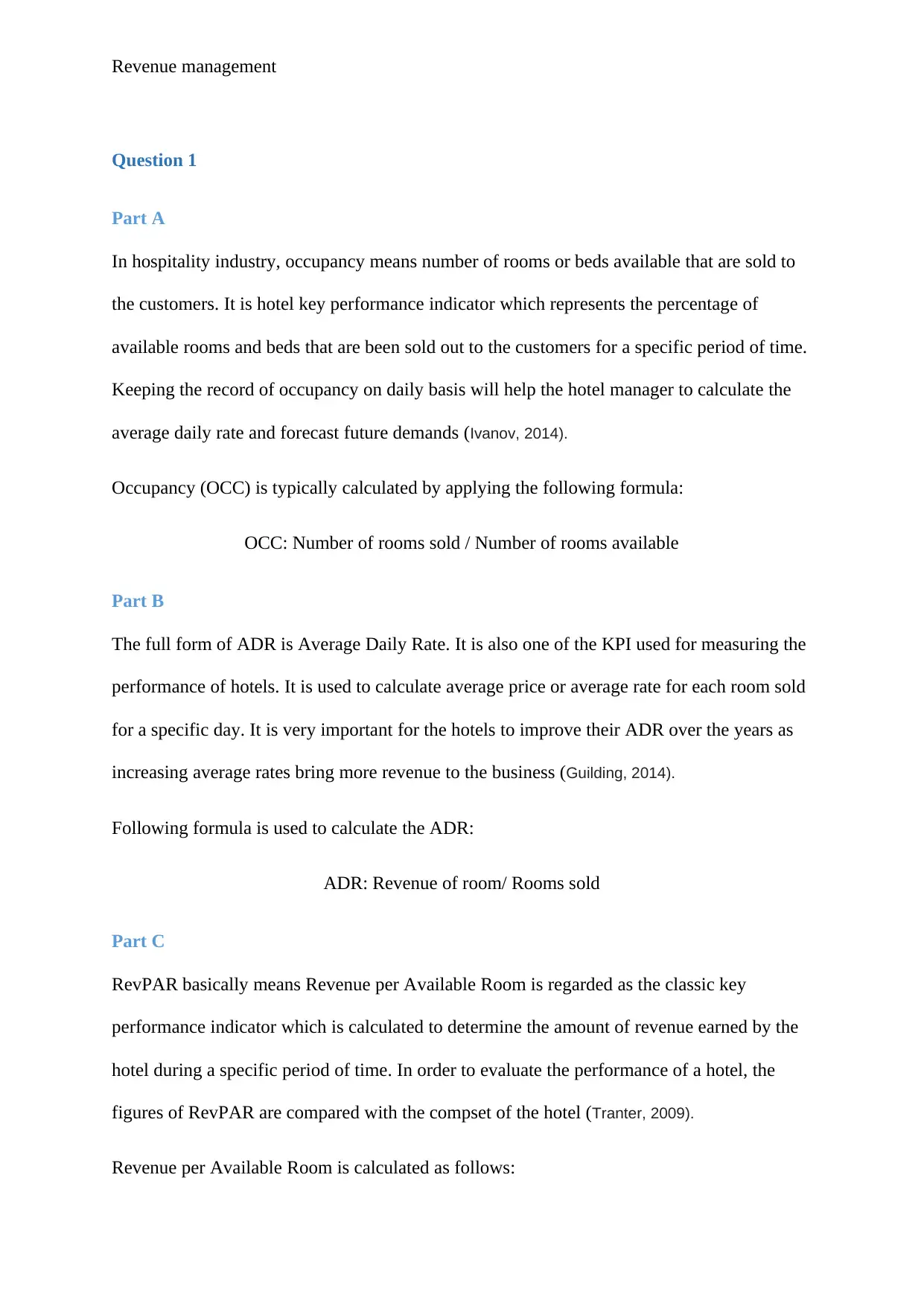
Revenue management
Question 1
Part A
In hospitality industry, occupancy means number of rooms or beds available that are sold to
the customers. It is hotel key performance indicator which represents the percentage of
available rooms and beds that are been sold out to the customers for a specific period of time.
Keeping the record of occupancy on daily basis will help the hotel manager to calculate the
average daily rate and forecast future demands (Ivanov, 2014).
Occupancy (OCC) is typically calculated by applying the following formula:
OCC: Number of rooms sold / Number of rooms available
Part B
The full form of ADR is Average Daily Rate. It is also one of the KPI used for measuring the
performance of hotels. It is used to calculate average price or average rate for each room sold
for a specific day. It is very important for the hotels to improve their ADR over the years as
increasing average rates bring more revenue to the business (Guilding, 2014).
Following formula is used to calculate the ADR:
ADR: Revenue of room/ Rooms sold
Part C
RevPAR basically means Revenue per Available Room is regarded as the classic key
performance indicator which is calculated to determine the amount of revenue earned by the
hotel during a specific period of time. In order to evaluate the performance of a hotel, the
figures of RevPAR are compared with the compset of the hotel (Tranter, 2009).
Revenue per Available Room is calculated as follows:
Question 1
Part A
In hospitality industry, occupancy means number of rooms or beds available that are sold to
the customers. It is hotel key performance indicator which represents the percentage of
available rooms and beds that are been sold out to the customers for a specific period of time.
Keeping the record of occupancy on daily basis will help the hotel manager to calculate the
average daily rate and forecast future demands (Ivanov, 2014).
Occupancy (OCC) is typically calculated by applying the following formula:
OCC: Number of rooms sold / Number of rooms available
Part B
The full form of ADR is Average Daily Rate. It is also one of the KPI used for measuring the
performance of hotels. It is used to calculate average price or average rate for each room sold
for a specific day. It is very important for the hotels to improve their ADR over the years as
increasing average rates bring more revenue to the business (Guilding, 2014).
Following formula is used to calculate the ADR:
ADR: Revenue of room/ Rooms sold
Part C
RevPAR basically means Revenue per Available Room is regarded as the classic key
performance indicator which is calculated to determine the amount of revenue earned by the
hotel during a specific period of time. In order to evaluate the performance of a hotel, the
figures of RevPAR are compared with the compset of the hotel (Tranter, 2009).
Revenue per Available Room is calculated as follows:
⊘ This is a preview!⊘
Do you want full access?
Subscribe today to unlock all pages.

Trusted by 1+ million students worldwide

Revenue management
RevPAR = Rooms revenue / Number of rooms available21
Question 2
Following three key findings can be derived by properly analysing the STR reports of the
hotel:
1. By looking at the STR reports, it can be said that in terms of RevPAR, the hotel has
performed pretty well as its revenue for the week has increased by 25.5% whereas the
compset or the market has shown an increase of 3.3% only. Hence, it can be said that
the performance of the hotel in terms of its revenue per available room is satisfying.
2. Looking at the average daily rate, it is noticed that hotel’s ADR has shown a huge
reduction of 9.8% in the whole week. As compare to the competitors, their ADR is
reduced only by 3.4%. This reduction in daily rate has impacted the occupancy of the
hotels.
3. The occupancy of the hotel is greater than its competitors as it is reported at 91.8%
with an increase of 39.1%. This is because of the low ADRs during the week. Market
occupancy has shown only an increase of 6.9% because of the high daily rate of
$69.39. Hence, it can be said that the hotel has performed well as compare to its
compset.
From the above findings, it can be concluded that the overall performance of the hotel has
been satisfactory in terms of its occupancy and revenue as compare to the market. Friday and
Saturday are the two worst performing days for the hotel. On Friday, the occupancy of the
hotel reduces along with its ADR. As a result of which, the RevPAR of the hotel was very
much lower than the market’s RevPAR. However, the occupancy of the hotel was more on
Friday as compare to its competitor; still its revenue was less than other week days. Talking
about Saturday, the occupancy of the hotel do increases but it was lower than the market. The
RevPAR = Rooms revenue / Number of rooms available21
Question 2
Following three key findings can be derived by properly analysing the STR reports of the
hotel:
1. By looking at the STR reports, it can be said that in terms of RevPAR, the hotel has
performed pretty well as its revenue for the week has increased by 25.5% whereas the
compset or the market has shown an increase of 3.3% only. Hence, it can be said that
the performance of the hotel in terms of its revenue per available room is satisfying.
2. Looking at the average daily rate, it is noticed that hotel’s ADR has shown a huge
reduction of 9.8% in the whole week. As compare to the competitors, their ADR is
reduced only by 3.4%. This reduction in daily rate has impacted the occupancy of the
hotels.
3. The occupancy of the hotel is greater than its competitors as it is reported at 91.8%
with an increase of 39.1%. This is because of the low ADRs during the week. Market
occupancy has shown only an increase of 6.9% because of the high daily rate of
$69.39. Hence, it can be said that the hotel has performed well as compare to its
compset.
From the above findings, it can be concluded that the overall performance of the hotel has
been satisfactory in terms of its occupancy and revenue as compare to the market. Friday and
Saturday are the two worst performing days for the hotel. On Friday, the occupancy of the
hotel reduces along with its ADR. As a result of which, the RevPAR of the hotel was very
much lower than the market’s RevPAR. However, the occupancy of the hotel was more on
Friday as compare to its competitor; still its revenue was less than other week days. Talking
about Saturday, the occupancy of the hotel do increases but it was lower than the market. The
Paraphrase This Document
Need a fresh take? Get an instant paraphrase of this document with our AI Paraphraser

Revenue management
percentage for the hotel was 7.4% while for the compset it was 13.4%. On the same day, the
ADR increases but lower than the market’s ADR. As a result of which, the RevPAR reduces
by 8.1% on Saturday. On these two days market has performed well as compare to the hotel.
One of the reasons for the bad performance on these two days may be the less number of
customers visiting the hotel and reduction in demand for the same. Another reason for this
may be the services provided by the hotel were not up to the mark and the slightest increase
in the daily rates for the room. All such reasons affected the potentiality of the hotel to
perform better.
Question 3
Apart from the STR reports, there are other ways also which a hotel manager can compare its
performance and make an analysis of its competitors. Two of them are as follows:
1. Creating excel spreadsheets by using Hotel Competitor Analysis Tool (H-CAT), a
strategic tool used by hotel managers to collect the data that enables a comparison
between the hotels on the basis of critical success factors. With the help of this tool,
the executive team of a hotel can assess its direct competitors and then on the basis of
the results make future planning in order to improve and enhance the performance of
the hotel (Enz & Thompson, 2011). The worksheets or spreadsheets prepared by H-CAT
are in proper format which allows the proper analysis of the key competitors
including their strengths and weaknesses. The main aim of this competitor analysis
tool is to help the hotel managers and other operators to enhance their performance
and to make significant modifications in their operations by conducting a meaningful
comparison and identifying the areas which requires improvement.
2. Another method is to take into account the process named as Search Engine
Optimization, abbreviated as SEO. It is a process employed by many hoteliers to
percentage for the hotel was 7.4% while for the compset it was 13.4%. On the same day, the
ADR increases but lower than the market’s ADR. As a result of which, the RevPAR reduces
by 8.1% on Saturday. On these two days market has performed well as compare to the hotel.
One of the reasons for the bad performance on these two days may be the less number of
customers visiting the hotel and reduction in demand for the same. Another reason for this
may be the services provided by the hotel were not up to the mark and the slightest increase
in the daily rates for the room. All such reasons affected the potentiality of the hotel to
perform better.
Question 3
Apart from the STR reports, there are other ways also which a hotel manager can compare its
performance and make an analysis of its competitors. Two of them are as follows:
1. Creating excel spreadsheets by using Hotel Competitor Analysis Tool (H-CAT), a
strategic tool used by hotel managers to collect the data that enables a comparison
between the hotels on the basis of critical success factors. With the help of this tool,
the executive team of a hotel can assess its direct competitors and then on the basis of
the results make future planning in order to improve and enhance the performance of
the hotel (Enz & Thompson, 2011). The worksheets or spreadsheets prepared by H-CAT
are in proper format which allows the proper analysis of the key competitors
including their strengths and weaknesses. The main aim of this competitor analysis
tool is to help the hotel managers and other operators to enhance their performance
and to make significant modifications in their operations by conducting a meaningful
comparison and identifying the areas which requires improvement.
2. Another method is to take into account the process named as Search Engine
Optimization, abbreviated as SEO. It is a process employed by many hoteliers to
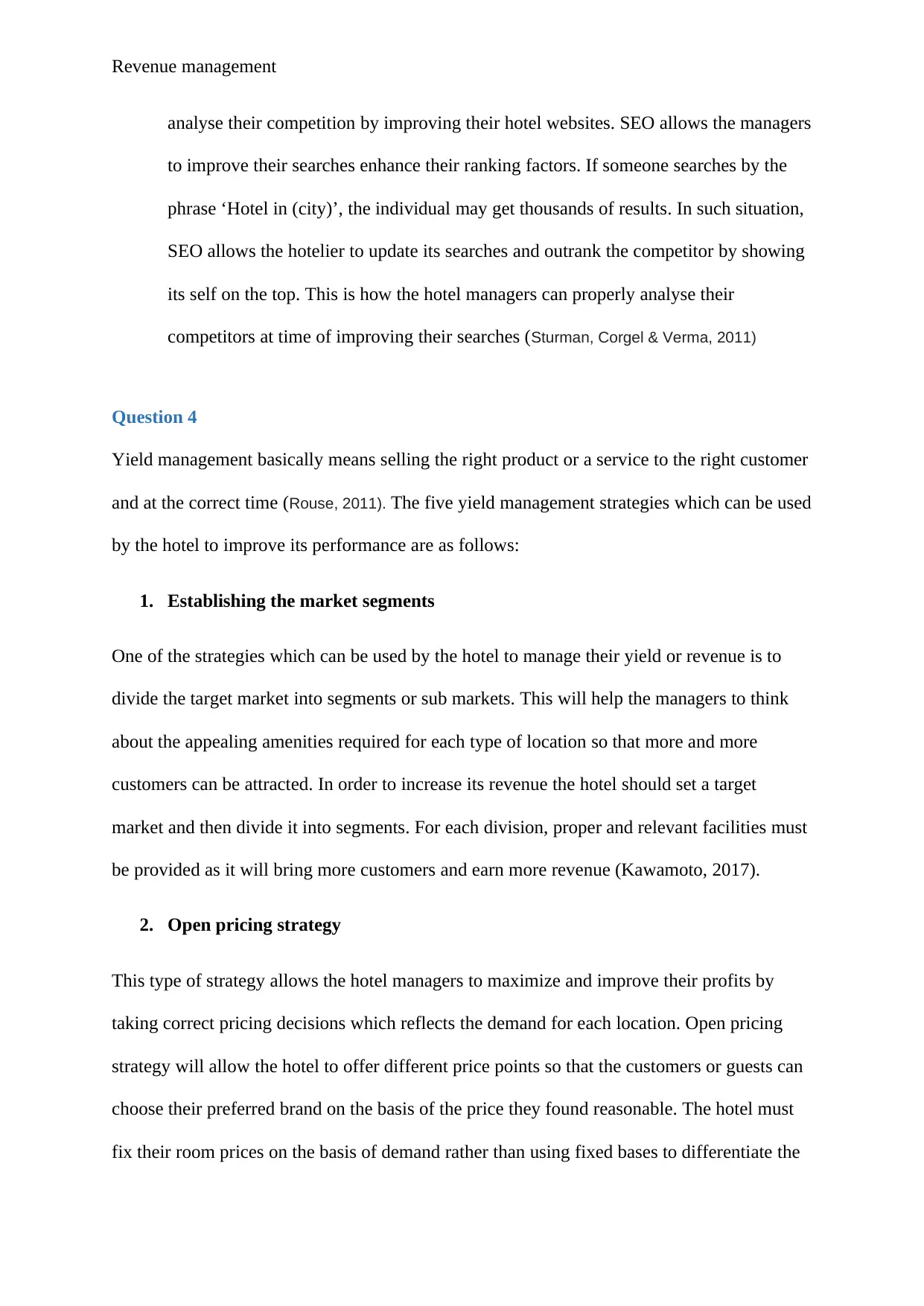
Revenue management
analyse their competition by improving their hotel websites. SEO allows the managers
to improve their searches enhance their ranking factors. If someone searches by the
phrase ‘Hotel in (city)’, the individual may get thousands of results. In such situation,
SEO allows the hotelier to update its searches and outrank the competitor by showing
its self on the top. This is how the hotel managers can properly analyse their
competitors at time of improving their searches (Sturman, Corgel & Verma, 2011)
Question 4
Yield management basically means selling the right product or a service to the right customer
and at the correct time (Rouse, 2011). The five yield management strategies which can be used
by the hotel to improve its performance are as follows:
1. Establishing the market segments
One of the strategies which can be used by the hotel to manage their yield or revenue is to
divide the target market into segments or sub markets. This will help the managers to think
about the appealing amenities required for each type of location so that more and more
customers can be attracted. In order to increase its revenue the hotel should set a target
market and then divide it into segments. For each division, proper and relevant facilities must
be provided as it will bring more customers and earn more revenue (Kawamoto, 2017).
2. Open pricing strategy
This type of strategy allows the hotel managers to maximize and improve their profits by
taking correct pricing decisions which reflects the demand for each location. Open pricing
strategy will allow the hotel to offer different price points so that the customers or guests can
choose their preferred brand on the basis of the price they found reasonable. The hotel must
fix their room prices on the basis of demand rather than using fixed bases to differentiate the
analyse their competition by improving their hotel websites. SEO allows the managers
to improve their searches enhance their ranking factors. If someone searches by the
phrase ‘Hotel in (city)’, the individual may get thousands of results. In such situation,
SEO allows the hotelier to update its searches and outrank the competitor by showing
its self on the top. This is how the hotel managers can properly analyse their
competitors at time of improving their searches (Sturman, Corgel & Verma, 2011)
Question 4
Yield management basically means selling the right product or a service to the right customer
and at the correct time (Rouse, 2011). The five yield management strategies which can be used
by the hotel to improve its performance are as follows:
1. Establishing the market segments
One of the strategies which can be used by the hotel to manage their yield or revenue is to
divide the target market into segments or sub markets. This will help the managers to think
about the appealing amenities required for each type of location so that more and more
customers can be attracted. In order to increase its revenue the hotel should set a target
market and then divide it into segments. For each division, proper and relevant facilities must
be provided as it will bring more customers and earn more revenue (Kawamoto, 2017).
2. Open pricing strategy
This type of strategy allows the hotel managers to maximize and improve their profits by
taking correct pricing decisions which reflects the demand for each location. Open pricing
strategy will allow the hotel to offer different price points so that the customers or guests can
choose their preferred brand on the basis of the price they found reasonable. The hotel must
fix their room prices on the basis of demand rather than using fixed bases to differentiate the
⊘ This is a preview!⊘
Do you want full access?
Subscribe today to unlock all pages.

Trusted by 1+ million students worldwide
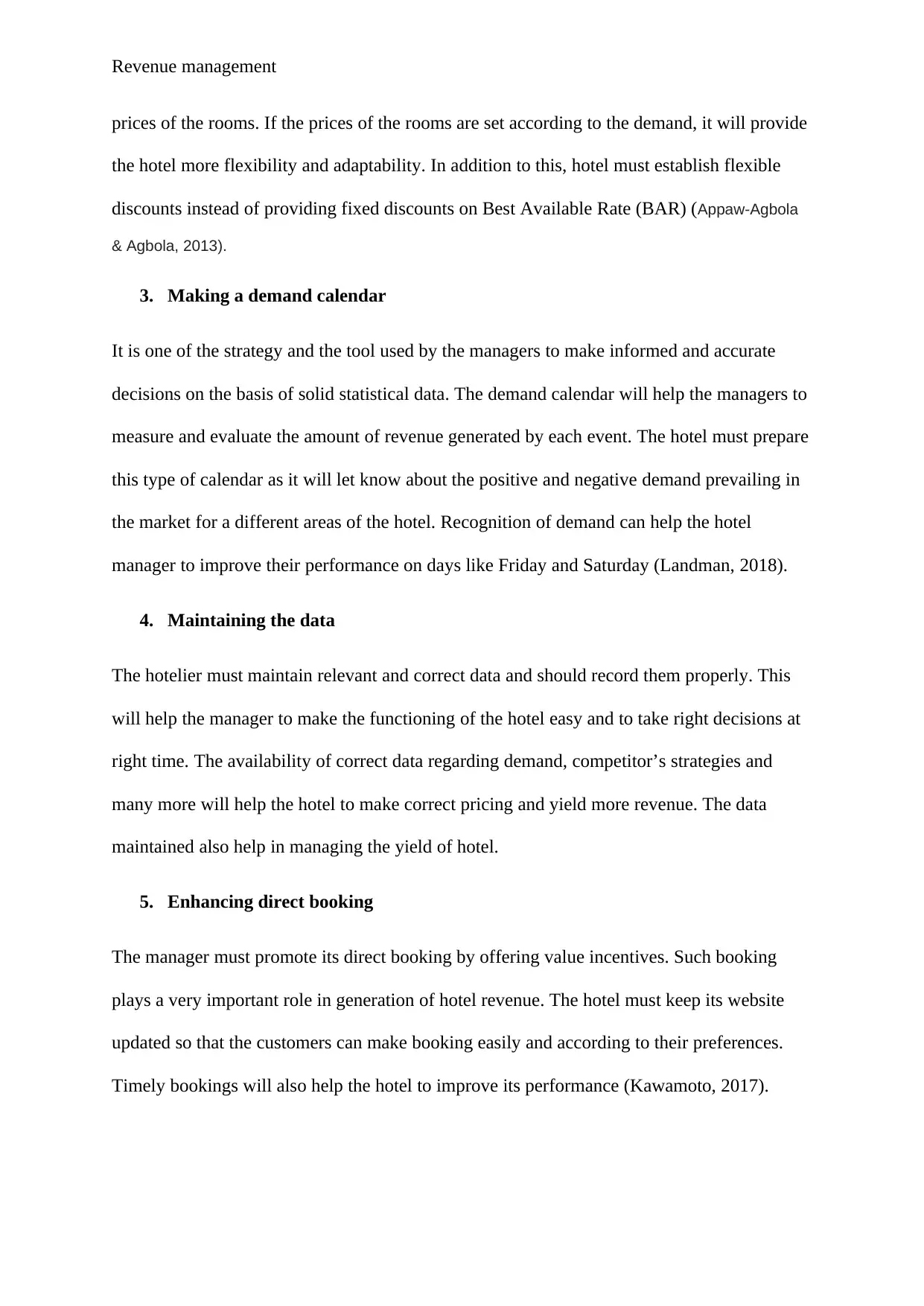
Revenue management
prices of the rooms. If the prices of the rooms are set according to the demand, it will provide
the hotel more flexibility and adaptability. In addition to this, hotel must establish flexible
discounts instead of providing fixed discounts on Best Available Rate (BAR) (Appaw-Agbola
& Agbola, 2013).
3. Making a demand calendar
It is one of the strategy and the tool used by the managers to make informed and accurate
decisions on the basis of solid statistical data. The demand calendar will help the managers to
measure and evaluate the amount of revenue generated by each event. The hotel must prepare
this type of calendar as it will let know about the positive and negative demand prevailing in
the market for a different areas of the hotel. Recognition of demand can help the hotel
manager to improve their performance on days like Friday and Saturday (Landman, 2018).
4. Maintaining the data
The hotelier must maintain relevant and correct data and should record them properly. This
will help the manager to make the functioning of the hotel easy and to take right decisions at
right time. The availability of correct data regarding demand, competitor’s strategies and
many more will help the hotel to make correct pricing and yield more revenue. The data
maintained also help in managing the yield of hotel.
5. Enhancing direct booking
The manager must promote its direct booking by offering value incentives. Such booking
plays a very important role in generation of hotel revenue. The hotel must keep its website
updated so that the customers can make booking easily and according to their preferences.
Timely bookings will also help the hotel to improve its performance (Kawamoto, 2017).
prices of the rooms. If the prices of the rooms are set according to the demand, it will provide
the hotel more flexibility and adaptability. In addition to this, hotel must establish flexible
discounts instead of providing fixed discounts on Best Available Rate (BAR) (Appaw-Agbola
& Agbola, 2013).
3. Making a demand calendar
It is one of the strategy and the tool used by the managers to make informed and accurate
decisions on the basis of solid statistical data. The demand calendar will help the managers to
measure and evaluate the amount of revenue generated by each event. The hotel must prepare
this type of calendar as it will let know about the positive and negative demand prevailing in
the market for a different areas of the hotel. Recognition of demand can help the hotel
manager to improve their performance on days like Friday and Saturday (Landman, 2018).
4. Maintaining the data
The hotelier must maintain relevant and correct data and should record them properly. This
will help the manager to make the functioning of the hotel easy and to take right decisions at
right time. The availability of correct data regarding demand, competitor’s strategies and
many more will help the hotel to make correct pricing and yield more revenue. The data
maintained also help in managing the yield of hotel.
5. Enhancing direct booking
The manager must promote its direct booking by offering value incentives. Such booking
plays a very important role in generation of hotel revenue. The hotel must keep its website
updated so that the customers can make booking easily and according to their preferences.
Timely bookings will also help the hotel to improve its performance (Kawamoto, 2017).
Paraphrase This Document
Need a fresh take? Get an instant paraphrase of this document with our AI Paraphraser
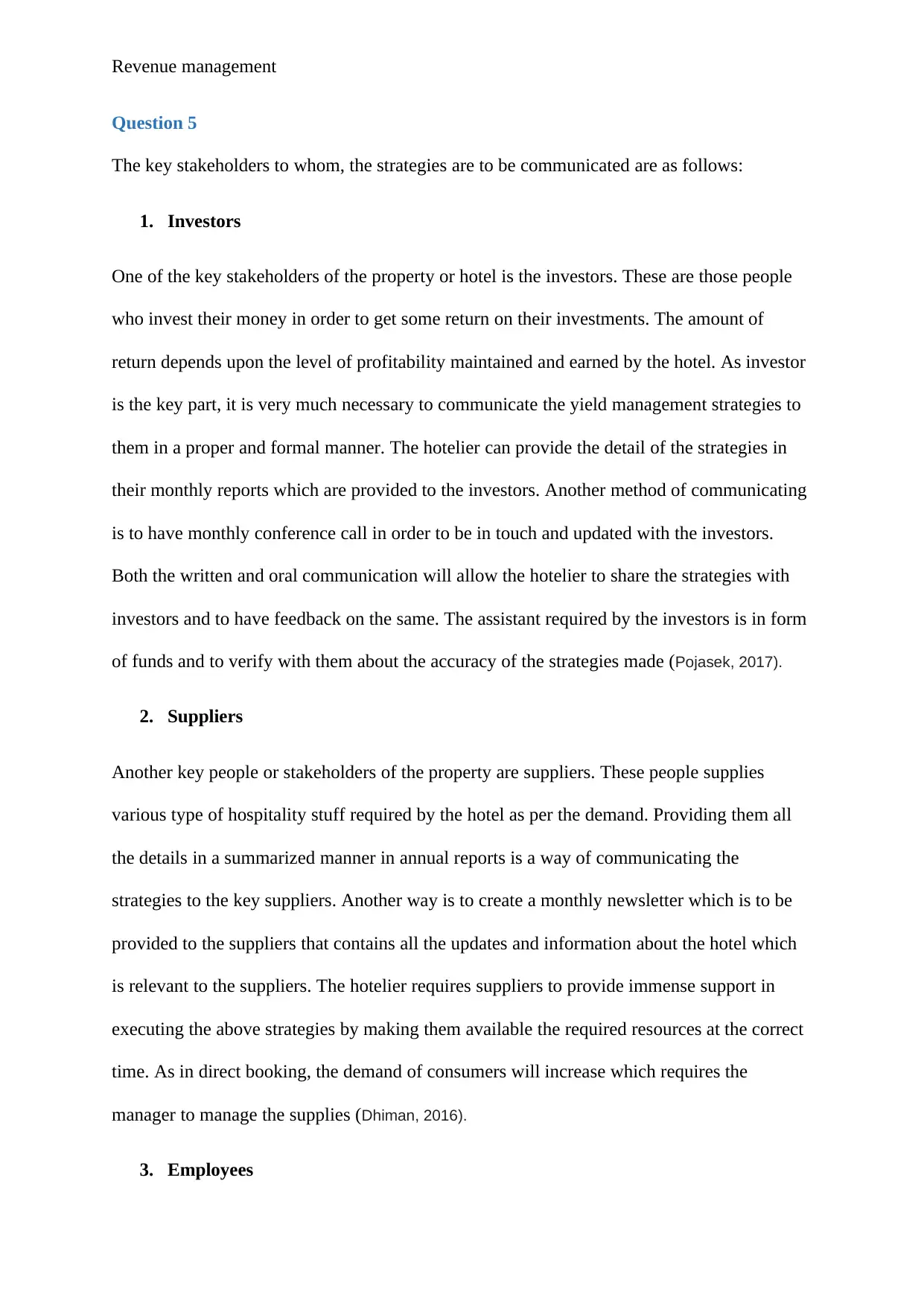
Revenue management
Question 5
The key stakeholders to whom, the strategies are to be communicated are as follows:
1. Investors
One of the key stakeholders of the property or hotel is the investors. These are those people
who invest their money in order to get some return on their investments. The amount of
return depends upon the level of profitability maintained and earned by the hotel. As investor
is the key part, it is very much necessary to communicate the yield management strategies to
them in a proper and formal manner. The hotelier can provide the detail of the strategies in
their monthly reports which are provided to the investors. Another method of communicating
is to have monthly conference call in order to be in touch and updated with the investors.
Both the written and oral communication will allow the hotelier to share the strategies with
investors and to have feedback on the same. The assistant required by the investors is in form
of funds and to verify with them about the accuracy of the strategies made (Pojasek, 2017).
2. Suppliers
Another key people or stakeholders of the property are suppliers. These people supplies
various type of hospitality stuff required by the hotel as per the demand. Providing them all
the details in a summarized manner in annual reports is a way of communicating the
strategies to the key suppliers. Another way is to create a monthly newsletter which is to be
provided to the suppliers that contains all the updates and information about the hotel which
is relevant to the suppliers. The hotelier requires suppliers to provide immense support in
executing the above strategies by making them available the required resources at the correct
time. As in direct booking, the demand of consumers will increase which requires the
manager to manage the supplies (Dhiman, 2016).
3. Employees
Question 5
The key stakeholders to whom, the strategies are to be communicated are as follows:
1. Investors
One of the key stakeholders of the property or hotel is the investors. These are those people
who invest their money in order to get some return on their investments. The amount of
return depends upon the level of profitability maintained and earned by the hotel. As investor
is the key part, it is very much necessary to communicate the yield management strategies to
them in a proper and formal manner. The hotelier can provide the detail of the strategies in
their monthly reports which are provided to the investors. Another method of communicating
is to have monthly conference call in order to be in touch and updated with the investors.
Both the written and oral communication will allow the hotelier to share the strategies with
investors and to have feedback on the same. The assistant required by the investors is in form
of funds and to verify with them about the accuracy of the strategies made (Pojasek, 2017).
2. Suppliers
Another key people or stakeholders of the property are suppliers. These people supplies
various type of hospitality stuff required by the hotel as per the demand. Providing them all
the details in a summarized manner in annual reports is a way of communicating the
strategies to the key suppliers. Another way is to create a monthly newsletter which is to be
provided to the suppliers that contains all the updates and information about the hotel which
is relevant to the suppliers. The hotelier requires suppliers to provide immense support in
executing the above strategies by making them available the required resources at the correct
time. As in direct booking, the demand of consumers will increase which requires the
manager to manage the supplies (Dhiman, 2016).
3. Employees
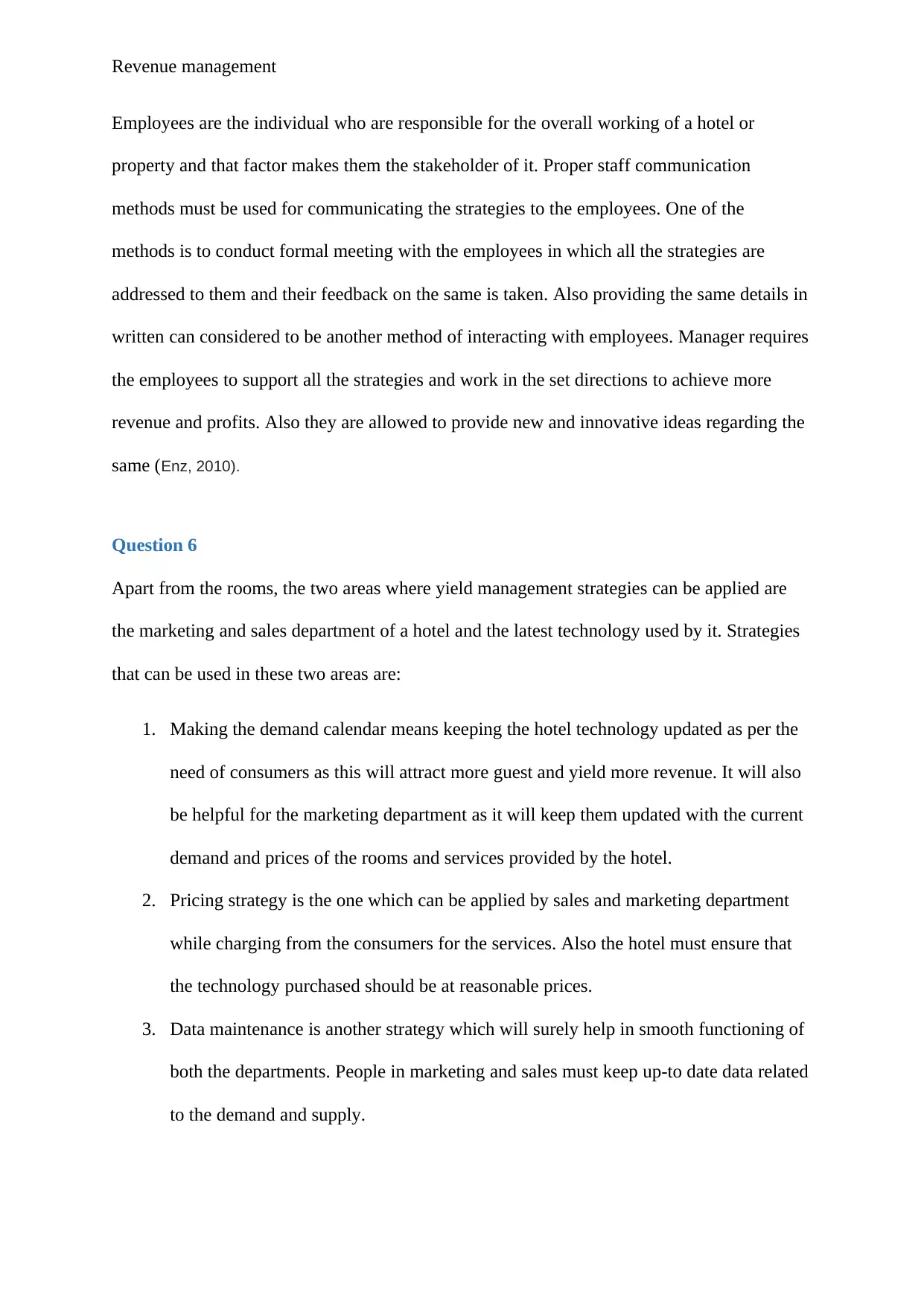
Revenue management
Employees are the individual who are responsible for the overall working of a hotel or
property and that factor makes them the stakeholder of it. Proper staff communication
methods must be used for communicating the strategies to the employees. One of the
methods is to conduct formal meeting with the employees in which all the strategies are
addressed to them and their feedback on the same is taken. Also providing the same details in
written can considered to be another method of interacting with employees. Manager requires
the employees to support all the strategies and work in the set directions to achieve more
revenue and profits. Also they are allowed to provide new and innovative ideas regarding the
same (Enz, 2010).
Question 6
Apart from the rooms, the two areas where yield management strategies can be applied are
the marketing and sales department of a hotel and the latest technology used by it. Strategies
that can be used in these two areas are:
1. Making the demand calendar means keeping the hotel technology updated as per the
need of consumers as this will attract more guest and yield more revenue. It will also
be helpful for the marketing department as it will keep them updated with the current
demand and prices of the rooms and services provided by the hotel.
2. Pricing strategy is the one which can be applied by sales and marketing department
while charging from the consumers for the services. Also the hotel must ensure that
the technology purchased should be at reasonable prices.
3. Data maintenance is another strategy which will surely help in smooth functioning of
both the departments. People in marketing and sales must keep up-to date data related
to the demand and supply.
Employees are the individual who are responsible for the overall working of a hotel or
property and that factor makes them the stakeholder of it. Proper staff communication
methods must be used for communicating the strategies to the employees. One of the
methods is to conduct formal meeting with the employees in which all the strategies are
addressed to them and their feedback on the same is taken. Also providing the same details in
written can considered to be another method of interacting with employees. Manager requires
the employees to support all the strategies and work in the set directions to achieve more
revenue and profits. Also they are allowed to provide new and innovative ideas regarding the
same (Enz, 2010).
Question 6
Apart from the rooms, the two areas where yield management strategies can be applied are
the marketing and sales department of a hotel and the latest technology used by it. Strategies
that can be used in these two areas are:
1. Making the demand calendar means keeping the hotel technology updated as per the
need of consumers as this will attract more guest and yield more revenue. It will also
be helpful for the marketing department as it will keep them updated with the current
demand and prices of the rooms and services provided by the hotel.
2. Pricing strategy is the one which can be applied by sales and marketing department
while charging from the consumers for the services. Also the hotel must ensure that
the technology purchased should be at reasonable prices.
3. Data maintenance is another strategy which will surely help in smooth functioning of
both the departments. People in marketing and sales must keep up-to date data related
to the demand and supply.
⊘ This is a preview!⊘
Do you want full access?
Subscribe today to unlock all pages.

Trusted by 1+ million students worldwide
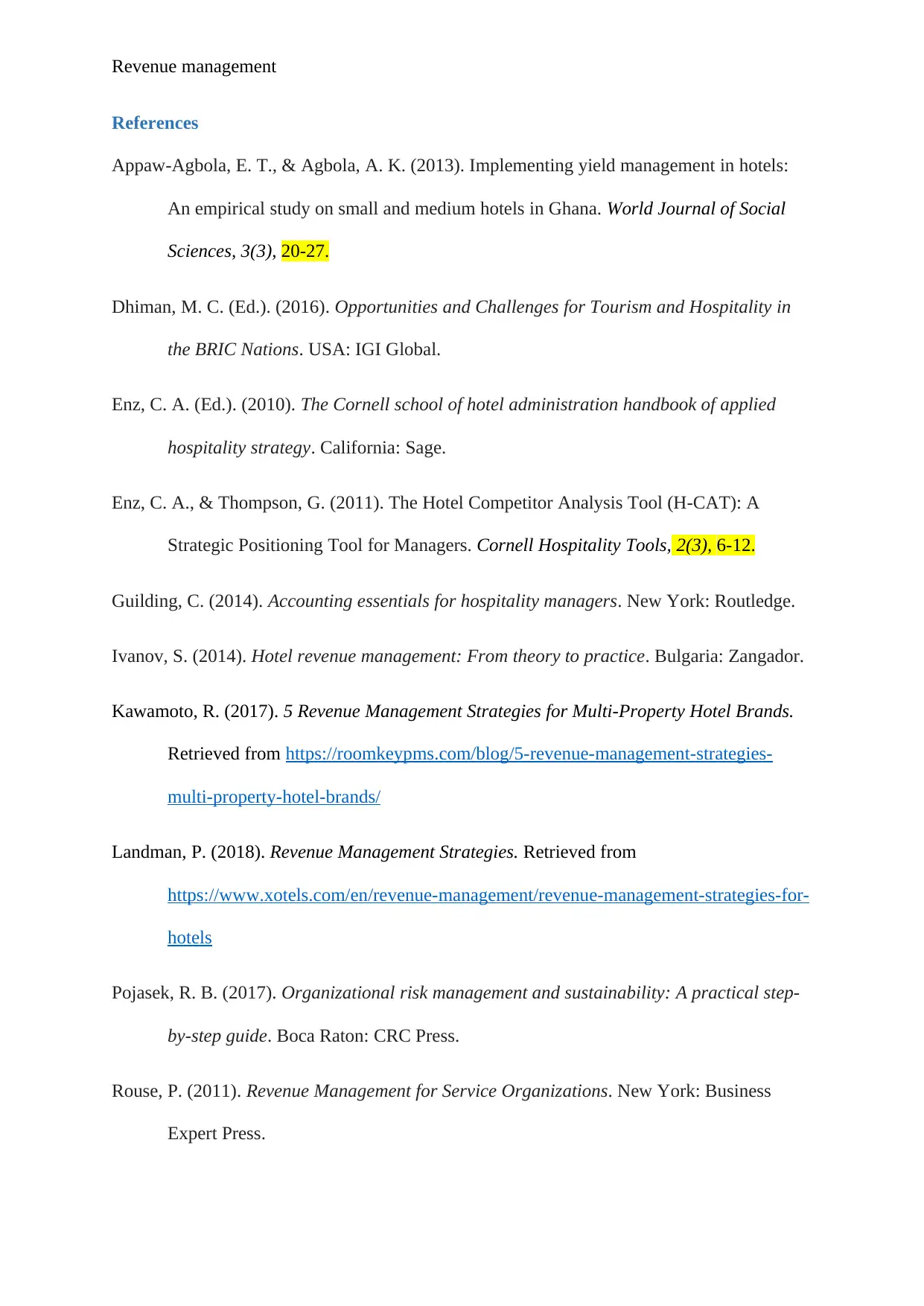
Revenue management
References
Appaw-Agbola, E. T., & Agbola, A. K. (2013). Implementing yield management in hotels:
An empirical study on small and medium hotels in Ghana. World Journal of Social
Sciences, 3(3), 20-27.
Dhiman, M. C. (Ed.). (2016). Opportunities and Challenges for Tourism and Hospitality in
the BRIC Nations. USA: IGI Global.
Enz, C. A. (Ed.). (2010). The Cornell school of hotel administration handbook of applied
hospitality strategy. California: Sage.
Enz, C. A., & Thompson, G. (2011). The Hotel Competitor Analysis Tool (H-CAT): A
Strategic Positioning Tool for Managers. Cornell Hospitality Tools, 2(3), 6-12.
Guilding, C. (2014). Accounting essentials for hospitality managers. New York: Routledge.
Ivanov, S. (2014). Hotel revenue management: From theory to practice. Bulgaria: Zangador.
Kawamoto, R. (2017). 5 Revenue Management Strategies for Multi-Property Hotel Brands.
Retrieved from https://roomkeypms.com/blog/5-revenue-management-strategies-
multi-property-hotel-brands/
Landman, P. (2018). Revenue Management Strategies. Retrieved from
https://www.xotels.com/en/revenue-management/revenue-management-strategies-for-
hotels
Pojasek, R. B. (2017). Organizational risk management and sustainability: A practical step-
by-step guide. Boca Raton: CRC Press.
Rouse, P. (2011). Revenue Management for Service Organizations. New York: Business
Expert Press.
References
Appaw-Agbola, E. T., & Agbola, A. K. (2013). Implementing yield management in hotels:
An empirical study on small and medium hotels in Ghana. World Journal of Social
Sciences, 3(3), 20-27.
Dhiman, M. C. (Ed.). (2016). Opportunities and Challenges for Tourism and Hospitality in
the BRIC Nations. USA: IGI Global.
Enz, C. A. (Ed.). (2010). The Cornell school of hotel administration handbook of applied
hospitality strategy. California: Sage.
Enz, C. A., & Thompson, G. (2011). The Hotel Competitor Analysis Tool (H-CAT): A
Strategic Positioning Tool for Managers. Cornell Hospitality Tools, 2(3), 6-12.
Guilding, C. (2014). Accounting essentials for hospitality managers. New York: Routledge.
Ivanov, S. (2014). Hotel revenue management: From theory to practice. Bulgaria: Zangador.
Kawamoto, R. (2017). 5 Revenue Management Strategies for Multi-Property Hotel Brands.
Retrieved from https://roomkeypms.com/blog/5-revenue-management-strategies-
multi-property-hotel-brands/
Landman, P. (2018). Revenue Management Strategies. Retrieved from
https://www.xotels.com/en/revenue-management/revenue-management-strategies-for-
hotels
Pojasek, R. B. (2017). Organizational risk management and sustainability: A practical step-
by-step guide. Boca Raton: CRC Press.
Rouse, P. (2011). Revenue Management for Service Organizations. New York: Business
Expert Press.
Paraphrase This Document
Need a fresh take? Get an instant paraphrase of this document with our AI Paraphraser
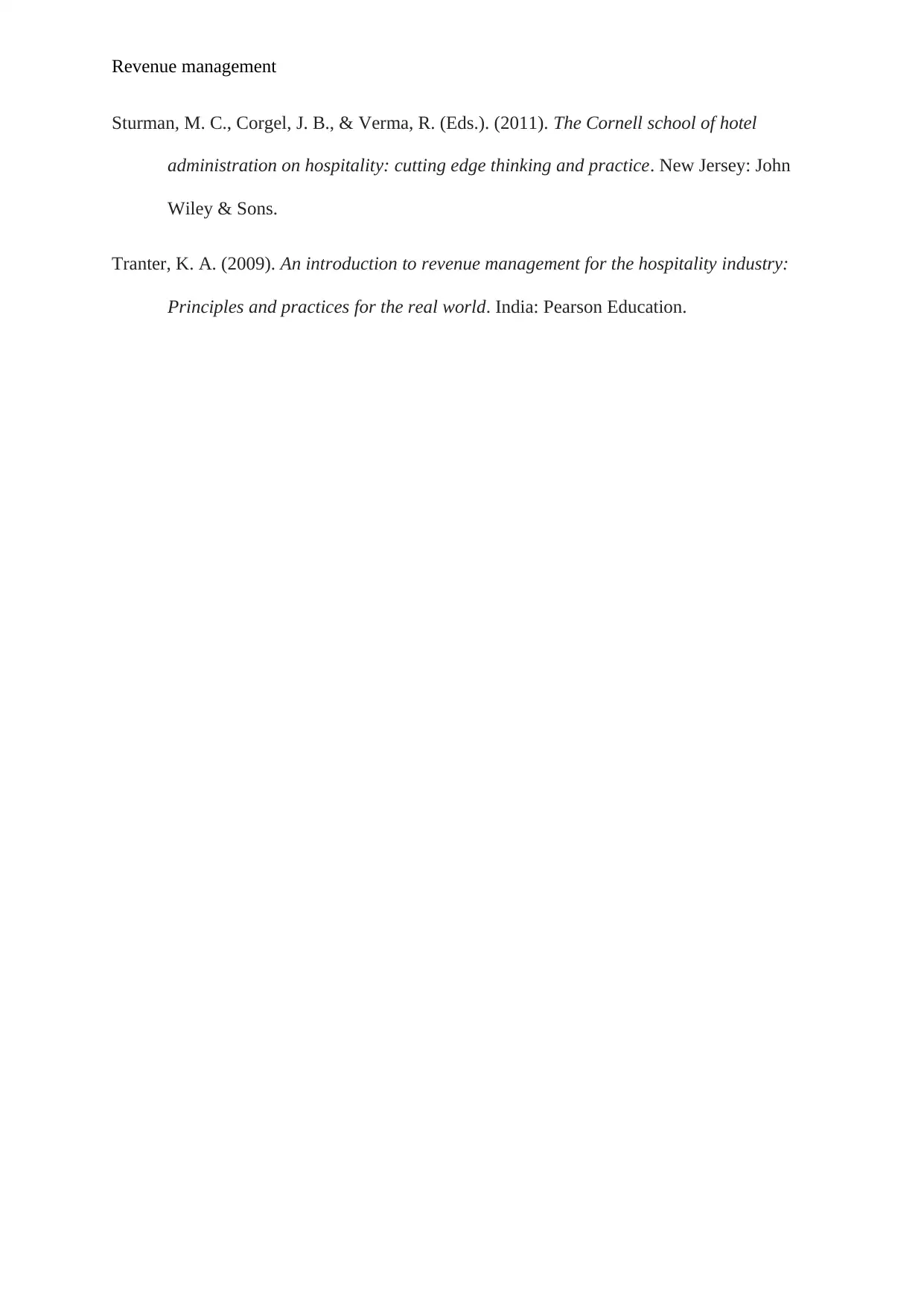
Revenue management
Sturman, M. C., Corgel, J. B., & Verma, R. (Eds.). (2011). The Cornell school of hotel
administration on hospitality: cutting edge thinking and practice. New Jersey: John
Wiley & Sons.
Tranter, K. A. (2009). An introduction to revenue management for the hospitality industry:
Principles and practices for the real world. India: Pearson Education.
Sturman, M. C., Corgel, J. B., & Verma, R. (Eds.). (2011). The Cornell school of hotel
administration on hospitality: cutting edge thinking and practice. New Jersey: John
Wiley & Sons.
Tranter, K. A. (2009). An introduction to revenue management for the hospitality industry:
Principles and practices for the real world. India: Pearson Education.
1 out of 11
Related Documents
Your All-in-One AI-Powered Toolkit for Academic Success.
+13062052269
info@desklib.com
Available 24*7 on WhatsApp / Email
![[object Object]](/_next/static/media/star-bottom.7253800d.svg)
Unlock your academic potential
Copyright © 2020–2025 A2Z Services. All Rights Reserved. Developed and managed by ZUCOL.





